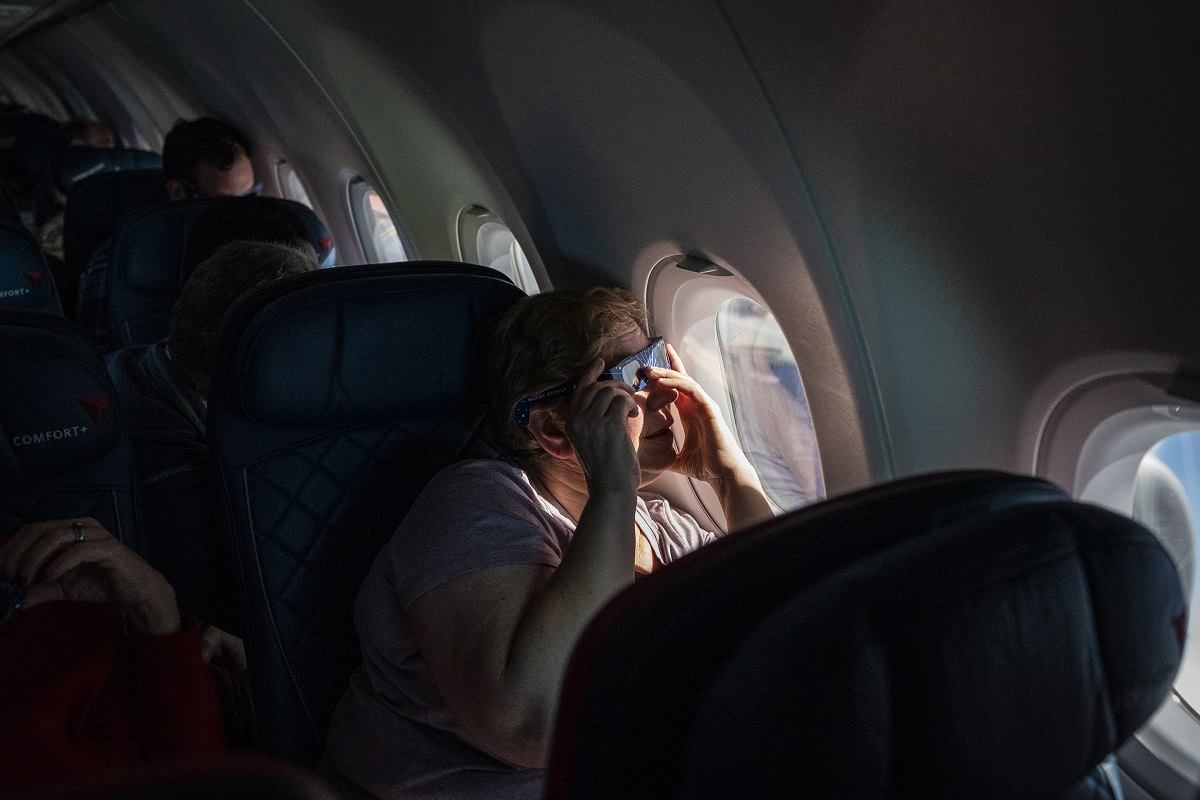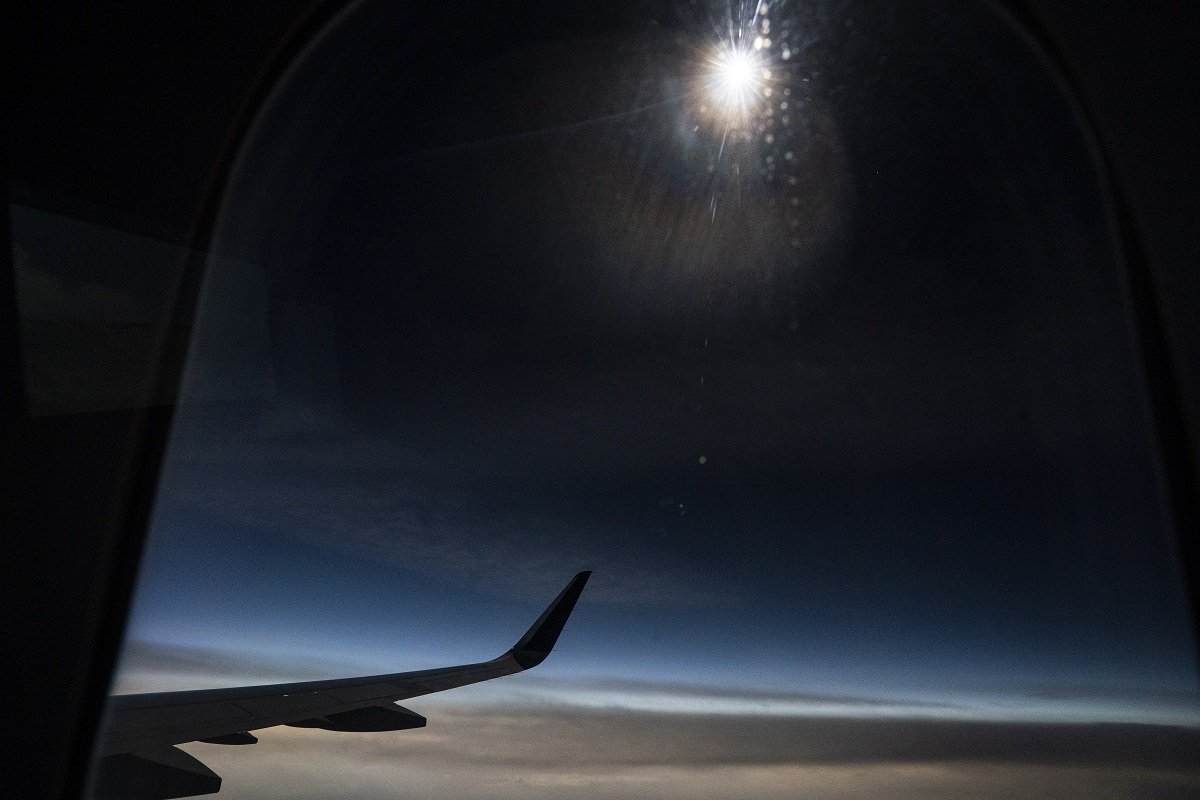
Kate Shamblott watches a solar eclipse through the window on Delta Air Lines flight 1010.
13:07 JST, April 9, 2024
SOMEWHERE OVER ARKANSAS – As skywatchers gathered across North America on Monday to peer up at a total solar eclipse, a plane full of Delta Air Lines passengers hoped to get a unique view from above the clouds.
But despite the efforts of the pilots on the route from Dallas to Detroit, a glimpse of totality proved elusive for many of the people who had reserved a spot on a flight that promised special maneuvers to get everyone a peek.
Passengers crowded near windows as the plane made a series of turns. However, the angle of the sun in the sky through much of the flight meant it was difficult to see much at all without craning your neck. Questions of “Did you see it?” bounced around the plane.
Kyle Carter, 40, a stay-at-home dad and private pilot from Orlando, said he didn’t see much of the actual eclipse during the flight, but he was happy with what he experienced.
“What I wanted to see, more than the actual eclipse itself, was just the shadow racing toward us from behind,” he said. “I did see that. You could see the darkness come towards us.”
Attorney Scot Kees and his daughter Gabrielle, 8, came from Atlanta for the flight. He said they “got a sliver” of the eclipse.
“Even though we didn’t get it completely, it was a fun community experience,” he said. He pointed out that clouds were an issue for many on the ground, so he’s not sure he would have seen more if he’d traveled somewhere else. “I’m glad we got to see what we did.”
Before people on the plane flew into a few minutes of totality, the lights were dimmed and the sky outside grew darker. Flight attendants and the pilot offered a couple of heads-ups. Seat-back screens showed the scenes elsewhere along the path of totality, including Mexico, then Texas and up through Indianapolis.
Passengers got a bag of swag that included “solar eclipse” Sun Chips, a Moon Pie, eclipse glasses, and Delta-branded socks and hat that said “climbing the cosmos.”
Captain Alex Howell said in an interview after the flight landed that he didn’t look at the sun during the flight, but saw the sky turn into a “dark version of dusk.”
“The city lights came on because of the darkness,” he said.
In the lead-up to the eclipse, several airlines publicized their best-chance flights for a prime viewing spot, with more than two dozen crisscrossing the country on Delta, United, Southwest, Alaska and other operators. They were careful to include caveats and make no promises.
“While Delta flight plans have been designed to maximize time within the path of totality, this is subject to change due to factors outside of Delta’s control such as weather and air traffic control that could impact timing and aircraft,” the airline warned.
Delta operated two dedicated eclipse flights from Texas on Monday, including one from Austin. On the flight from Austin to Detroit, a couple wearing eclipse shirts got engaged after passing through totality.
“Everyone was clapping and yelling and just really happy for them,” said Delta spokeswoman Catherine Morrow, who was on the flight. The captain piped up from the flight deck to ask the outcome.
In Dallas, the airport scene was festive Monday morning. Passengers walked under a celestial-themed balloon arch to board, airline representatives handed out glasses and a Yorkie named Delilah posed for photos with her humans.
“It’s her first eclipse, how could she miss it?” said Alan Goldberg, 70, an attorney who lives in New York City and Florida. Monday was Delilah the dog’s second birthday.
Thomas Iwinski, a 34-year-old meteorologist from Detroit, flew to Dallas Monday morning to get on the flight back home that would transport passengers along the path of totality. He described the mood at the gate as “ecstatic, joyful, elated.” He rented a home in Tennessee for the 2017 eclipse but didn’t want to take a chance on clouds this time.
“It’s definitely going to be something that I’ve never experienced before,” he said.
The airline had been planning for the flights for months.
In October, an operations planning staffer mentioned the upcoming eclipse. That led to some brainstorming and spitballing, said Chris Clisham, a flight superintendent at the airline, in a phone interview.
“And dot dot dot, here we are,” he said.
The logistics sound like an SAT word problem: If the plane is traveling at 400 mph and the moon’s shadow is racing at 1,600 mph, where will they overlap? And for how long? Throw in the angle of the sun while you’re at it.
“Fortunately, even though I am a math major, I didn’t have to bring any trigonometry into this equation,” Clisham said. Flight-planning software did the heavy lifting.
The airline first announced an Austin-to-Detroit flight in mid-February, describing it as “specifically for umbraphiles to be able to spend as much time as possible directly within the path of totality.” That flight sold out in a day, so Delta quickly added another one, this time from Dallas.
Jamie Larounis, a D.C.-based travel industry analyst with UpgradedPoints.com, had no special plans to see the eclipse. He was intrigued by Delta’s first flight, but it sold out before he could snag a seat. Then he saw a news release about the Dallas flight.
“Within 30 seconds, I had it booked,” he said. “I dropped everything.”
Before the flight, he said, he dropped 107,500 airline miles to book a first-class seat on the left side of the plane, equivalent to about $1,149. Anyone who heard about the plan assumed he has an extreme interest in eclipses, but he said he is more of an aviation buff.
“They all think I’m some sort of meteorologist, am I some sort of physics whatever,” said Larounis, 34.
Melanie Elliott, 36, of Chapel Hill, N.C., was disappointed to have missed the Austin flight so she leaped at the chance to fly out of Dallas. An astronomy fan who got a degree in physics, she was wearing astronaut earrings, a solar system necklace and a star and moon ring. After the flight, she said the view of totality – as she “was like laying on the right side of the seat” to try to see – was “a little disappointing.” She said she’ll watch her next eclipse from the ground.
But there was one huge perk for her: Astronaut Scott Kelly spoke at a post-flight party in Detroit and posed for pictures with passengers.
“Scott Kelly touched my moon tattoo,” Elliott said. “Kind of worth it.”
During the last eclipse visible from North America, in 2017, photographer Jon Carmichael tried to win a spot on a special Alaska Airlines flight so he could photograph the eclipse from the sky. He lost out, but pored over flight schedules and compared them with the eclipse path to find a Southwest flight from Portland, Ore., to St. Louis.
With the help of the pilots – one of whom even cleaned the window outside Carmichael’s seat before taking off – he took about 1,200 photos that formed an iconic photo mosaic documenting the eclipse.
Carmichael, who has also photographed an eclipse from land, said there are pros and cons to being in the air. The experience on the ground is more immersive; there are temperature changes, reactions from wildlife and the view is not obstructed by parts of a plane.
But in the sky, clouds are much less likely to get in the way. And, he said, it’s possible to see the moon’s shadow moving across the earth on the ground – a view unavailable to eclipse watchers for most of human history.
“We’ve only been flying as a human race for a little over 100 years; that’s only the blink of an eye,” he said. “It really gives you a sense of the scale of the universe that we’re part of this huge incredible celestial system where you actually can see the moon’s shadow being cast onto the Earth, moving across the Earth.”

The solar eclipse, seen through an airplane window during a path of totality Delta Air Lines flight.
"News Services" POPULAR ARTICLE
-

American Playwright Jeremy O. Harris Arrested in Japan on Alleged Drug Smuggling
-

Japan’s Nikkei Stock Average as JGB Yields, Yen Rise on Rate-Hike Bets
-

Japan’s Nikkei Stock Average Licks Wounds after Selloff Sparked by BOJ Hike Bets (UPDATE 1)
-

Japan’s Nikkei Stock Average Buoyed by Stable Yen; SoftBank’s Slide Caps Gains (UPDATE 1)
-

Japanese Bond Yields Zoom, Stocks Slide as Rate Hike Looms
JN ACCESS RANKING
-

Keidanren Chairman Yoshinobu Tsutsui Visits Kashiwazaki-Kariwa Nuclear Power Plant; Inspects New Emergency Safety System
-

Imports of Rare Earths from China Facing Delays, May Be Caused by Deterioration of Japan-China Relations
-

University of Tokyo Professor Discusses Japanese Economic Security in Interview Ahead of Forum
-

Tokyo Economic Security Forum to Hold Inaugural Meeting Amid Tense Global Environment
-

Japan Pulls out of Vietnam Nuclear Project, Complicating Hanoi’s Power Plans






















